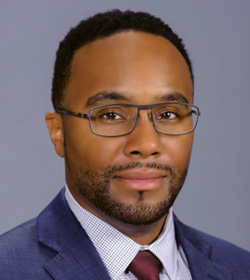Specifically Speaking with Samuel D. Trotman Director of Integrated Technology for Kadrmas, Lee & Jackson (KLJ) Integrated Technology, based in St. Paul, Minn.

By Paul Ragusa
Updated Wed January 24, 2018
 What's your role at the company?
What's your role at the company?
I serve as the lead technical consultant and senior business development manager for the Kadrmas, Lee & Jackson (KLJ) Integrated Technology practice with a focus on structuring and strategically growing the KLJ regional Integrated Technology market into a national footprint. My current responsibilities include serving as the technical design lead driving innovative technology solutions within projects across various business groups (e.g. smart cities, intelligent transportation systems, aviation, seaports, municipal, telecommunications, critical infrastructure, power, and healthcare), providing leadership and mentoring for a team of engineering and technology professionals, and helping to define team organization and composition for execution and delivery of projects.
What kinds of systems do you design/specify and what services does the company provide?
The Integrated Technology division of KLJ focuses on implementing comprehensive technology solutions across various verticals that are developed utilizing a holistic approach. This can range from the design of an integrated security system, which includes components such as an enterprise-level electronic access control system, video management system and storage, intercom system and mass notification deployed within a building or across a campus to an Intelligent Transportation Systems deployment to the development of an architecture for a Smart Cities initiative.
KLJ provides engineering consulting services under which we develop engineering documents such as Concept of Operations (ConOps) documents, feasibility and planning studies, policy development, evaluation of new and emerging technologies, technical specifications, permittable construction plan set packages, traffic simulation modeling, surveying, and much more in an effort to create an exceptional experience for our clients.
What vertical markets does the company specialize in?
We are currently structured into workgroups that focus on the following business sectors: Aviation, environmental, funding resources, land resources, land development, oil & gas, power, public works, right-of-way, structural, survey, telecommunications, transportation, and water resources.
How did you get started in security and designing/specifying?
I initially started off in the field of Intelligent Transportation Systems (ITS) where I designed fiber optic and wireless networks to facilitate the communications for connected ITS edge devices and sensors (e.g. traffic cameras, dynamic message signs, bluetooth readers, microwave vehicle detection systems, etc.) deployed along highways, interstates, and major corridors onto various networks to provide real-time traffic data back to local and regional Traffic Management Centers (TMCs). From there I used my background and experience implementing communications networks and integrated technology concepts acquired from previous ITS deployments and applied them to the design of communication networks and video camera surveillance systems at seaports.
I then started designing expansions to existing electronic access control systems, which were required to be integrated with the video camera surveillance system. As I gained more experience and expertise with integrating various facets of electronic security systems with complimentary technology systems it created opportunities that allowed me to provide comprehensive integrated technology solutions in the aviation, municipal, and other critical infrastructure facilities markets.
Can you talk about what new or emerging technologies you are seeing or specifying today?
I would say the most interesting and impactful would have to be the Internet of Things (IoT) technologies. I wouldn't necessarily classify them as a new technology, but more so an emerging technology due to their current seemingly unstructured nature (i.e. not universally being defined by any one particular industry or bound/governed by an adopted set of standards) and their recent penetration across basically all verticals in today's marketplace. IoT devices and sensors, which may come in the form of cameras, Bluetooth readers, Radio-frequency Identification (RFID) tags, microwave detection sensors, etc., are now capable of capturing, generating, and transmitting more data about the environment in which they are being deployed than ever before.
However, a stronger focus is being placed on the open architecture platforms that are utilized to aggregate, filter, and correlate the vast amounts of data being generated by these devices in an effort to produce useful and actionable information—big data analytics. These platforms can facilitate the convergence of artificial intelligence (AI) and machine learning with big data that is revolutionizing today's technologies and serving as transformative tools unlocking capabilities previously unavailable and in some cases unimagined. A great deal of the technologies that I am specifying today are now considered IoT devices or sensors, but the platforms that integrate these devices remain the core of the conversation.
What is your view on the industry moving forward?
I believe that the industry moving forward needs to focus on open-source/non-proprietary platform solutions that provide end-to-end resiliency and interoperability among various technology offerings. With the net-centric nature of the technologies being deployed, consultants, solution architects, and system integrators must ensure that the technology and security solutions being designed to protect critical assets implement proper safeguards to defend against cyber and other threat agents to ensure vulnerabilities are not inadvertently introduced into the environment.
Both an assignment of duties and designation of responsibilities must be clearly defined by consultants and/or solution architects to prevent any gaps of coverage by system integrators and contractors because those tasks were not spelled out in the advertised scope of services included in the bid documents.
We are entering into what may be considered another “golden age” with the recent advancements in technology we are witnessing with regards to the functionality and capabilities, processing power, and connectivity of these devices, so it is definitely an exciting time to be a part of the industry. As security and technology professionals, I feel we need to not only be cognizant of the new challenges and obstacles (e.g. cyber threats) before us, but vigilant in our resiliency efforts as we continue to pursue secure innovative avenues and techniques to implement the overall vision of our clients in this rapidly changing landscape.
Comments